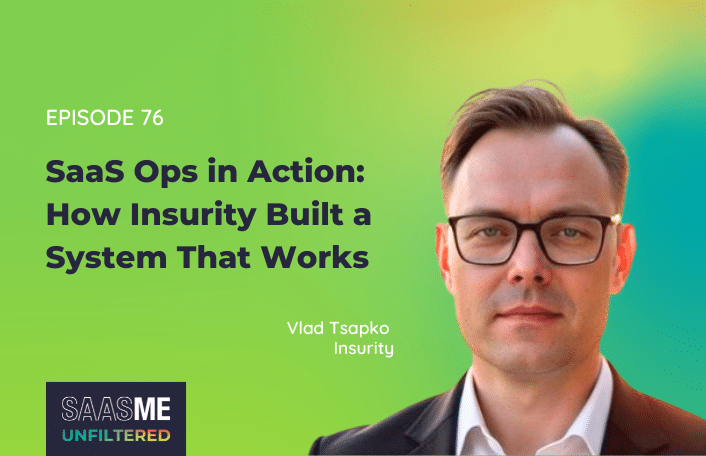
SaaS Vendor Management: From Sprawl to Control
Table of Contents ToggleChaptersEpisode SummaryGuest SpotlightEpisode Highlights1. SaaS Operations Needs a...
Back
Back
Search for Keywords...
Blog

09/30/2025
Table of Contents
SaaS sprawl doesn’t fix itself—smart operations do. Vlad Tsapko, VP of Business Operations at Insurity, breaks down how his team built a functional, data-driven SaaS Management program that reduces waste and supports business growth. In this episode, you’ll hear why SaaS Ops is essential for managing big software spend, how data integrity supports smarter decisions, and why continuous improvement keeps the program effective over time.
SaaS Operations isn’t just another business function. At Insurity, it serves as the backbone for managing software at scale.
Vlad Tsapko helped transform Insurity’s fragmented software environment into a data-driven SaaS Management program that earned credibility across procurement, finance, and HR. This kind of transformation doesn’t happen overnight.
The story starts with a familiar challenge: shadow IT, over-provisioned subscriptions, and poor vendor deals. Rather than rely on tooling alone, Vlad and his team focused on what mattered—process, data integrity, and stakeholder engagement. Trust wasn’t assumed. It was earned by consistently delivering results.
“We’re not just coming to our finance team saying we want to spend X,” shared Vlad. “We’re saying: we’ll fund it—either fully or partially—through savings.”
The first step was visibility. The team replaced SharePoint with a true system of record and standardized on Zylo. But Vlad didn’t rush implementation. He knew that without clean data and engaged stakeholders, even the best platform would fall short.
His approach was simple: start small. Deliver meaningful wins for early adopters. Use those stories to bring others on board. Over time, the process scaled—automated workflows, renewal playbooks, and a culture of continuous feedback created long-term momentum.
Vlad stressed the importance of this first step. “Data integrity is extremely important. Without the input from every single app owner, there is no data integrity.”
The result is more than operational efficiency. Now, Insurity makes informed SaaS decisions that align with financial planning, improve renewal outcomes, and reduce waste across the business.
This episode is essential listening for IT and business operations leaders ready to move beyond reactive SaaS Management. Vlad’s approach proves that progress doesn’t require mandates. It starts with results—and results build buy-in.
Vlad sees SaaS Ops as a critical governance function, not just an administrative task. Without it, the business faces increased complexity, risk, and cost. At Insurity, SaaS Operations spans FinOps and vendor management to drive visibility and financial control.
“There absolutely is [a need]. Of course, it depends on the organizational needs and future growth. But overall, there definitely is a need for a controlling and a governing body, to run all of those processes as smoothly as possible and to help the business navigate through these complex changes. Every single business process is a living thing. It keeps changing. Not having the ops team on the SaaS side makes it way more complicated for the business to grow and introduces an additional risk of shadow IT.”
During the first phase of the program, Vlad’s team discovered over-provisioned subscriptions and poorly negotiated contracts. Rather than blame stakeholders, they responded by formalizing processes and guiding the business with data.
“We uncovered a lot of interesting things, mostly unpleasant—especially when it comes to shadow IT and the practices stakeholders were using to negotiate and size agreements. We found a lot of over-provisioned subscriptions. We found a lot of bad deals. It’s not their strongest skill set to be doing these types of things. You need to understand what the benchmark is. You need to know when the vendor’s quarter ends, their fiscal year. It is a function that is gradually becoming a science, and you have to be the professor of that science. You educate your business, and you’re looking for ways to put the top performers as examples and show how others can improve. That’s the game we’re trying to play.”
Instead of treating SaaS renewals as isolated events, Vlad’s team folded SaaS cost savings into the company’s broader budget planning. That alignment with finance created a new level of credibility and long-term impact.
“When we realized the actual value of the program, we knew we needed to start showing those savings. We’re not just going to finance saying we want to spend X. We’re saying, ‘We want to spend X because—and we’re going to fully or partially fund it through savings.’ This isn’t just budget planning or forecasting. It’s a continuous process. You keep feeding that information to the forecast, to the finance team. And then they become your biggest supporter if you’re doing your job right. You start working together. You start realizing the value of this collaboration. You become good friends with the CFO. What could be better?”
Building a trustworthy system of record required more than just tool implementation. Vlad’s team took ownership of operationalizing the data but relied on the entire business to contribute. App owners became active participants in ensuring every renewal and every decision was backed by accurate data.
“Data integrity is extremely important. Without the input from every single app owner, there is no data integrity. The entire organization provides input. At the beginning, our system of record was SharePoint, and it came with challenges. When we adopted Zylo, we started using it the same way we used SharePoint, and we realized: we can’t do that. Our data isn’t clean enough. So we went through a data cleanup exercise and only after that did we launch what we really wanted to launch.”
Vlad treats every renewal as a decision point. His team prepares in advance with usage data, stakeholder input, and prebuilt workflows tailored by contract size. That preparation makes the difference between overspending and enabling the business with the right tools.
“We have thresholds. We’re not investing time into a $1,000 renewal. But when it’s a big subscription, we start early. We run usage analysis, share findings with stakeholders, and propose a strategy. Sometimes we push back because it’s over-provisioned. Other times we find denied access tickets and discover we actually need more. It’s not just about savings. We’re helping employees and teams get what they need. In one case, we renewed a subscription, added users, and hit a 95% adoption rate within two months.”
Vlad Tsapko built a SaaS Operations model at Insurity that drives real business outcomes — cost savings, cleaner data, and stronger alignment with finance, procurement, and HR. His team’s success is grounded in process discipline, stakeholder education, and full visibility into software usage and spend.
If you’re leading IT, procurement, or business operations, this episode offers a practical blueprint for turning SaaS chaos into a well-governed program with long-term impact.
Want more stories like this? Subscribe to SaaSMe Unfiltered on your favorite podcast platform.
ABOUT THE AUTHOR

Cory Wheeler
As Zylo’s Chief Customer Officer, Cory is responsible for helping our customers drive ROI and SaaS Management success with Zylo. He helps companies of all sizes effectively discover, optimize, and govern their SaaS through Zylo’s platform and services. Prior to founding Zylo, Cory spent 15 years in finance and procurement, managing categories and sourcing teams at Arthur Andersen, BearingPoint, and both Takeda and Astellas Pharmaceuticals. He built the procurement organization at ExactTarget, and managed the integration with the Salesforce Marketing Cloud procurement organization in 2015. He and his family reside in Indianapolis, IN, where they can be found cheering for the Purdue Boilermakers and Chicago Cubs.

Table of Contents ToggleChaptersEpisode SummaryGuest SpotlightEpisode Highlights1. SaaS Operations Needs a...

Table of Contents ToggleChaptersEpisode SummaryGuest SpotlightEpisode Highlights1. SaaS Operations Needs a...

Table of Contents ToggleChaptersEpisode SummaryGuest SpotlightEpisode Highlights1. SaaS Operations Needs a...

Table of Contents ToggleChaptersEpisode SummaryGuest SpotlightEpisode Highlights1. SaaS Operations Needs a...
| Cookie | Duration | Description |
|---|---|---|
| cookielawinfo-checkbox-analytics | 11 months | This cookie is set by GDPR Cookie Consent plugin. The cookie is used to store the user consent for the cookies in the category "Analytics". |
| cookielawinfo-checkbox-functional | 11 months | The cookie is set by GDPR cookie consent to record the user consent for the cookies in the category "Functional". |
| cookielawinfo-checkbox-necessary | 11 months | This cookie is set by GDPR Cookie Consent plugin. The cookies is used to store the user consent for the cookies in the category "Necessary". |
| cookielawinfo-checkbox-others | 11 months | This cookie is set by GDPR Cookie Consent plugin. The cookie is used to store the user consent for the cookies in the category "Other. |
| cookielawinfo-checkbox-performance | 11 months | This cookie is set by GDPR Cookie Consent plugin. The cookie is used to store the user consent for the cookies in the category "Performance". |
| viewed_cookie_policy | 11 months | The cookie is set by the GDPR Cookie Consent plugin and is used to store whether or not user has consented to the use of cookies. It does not store any personal data. |
